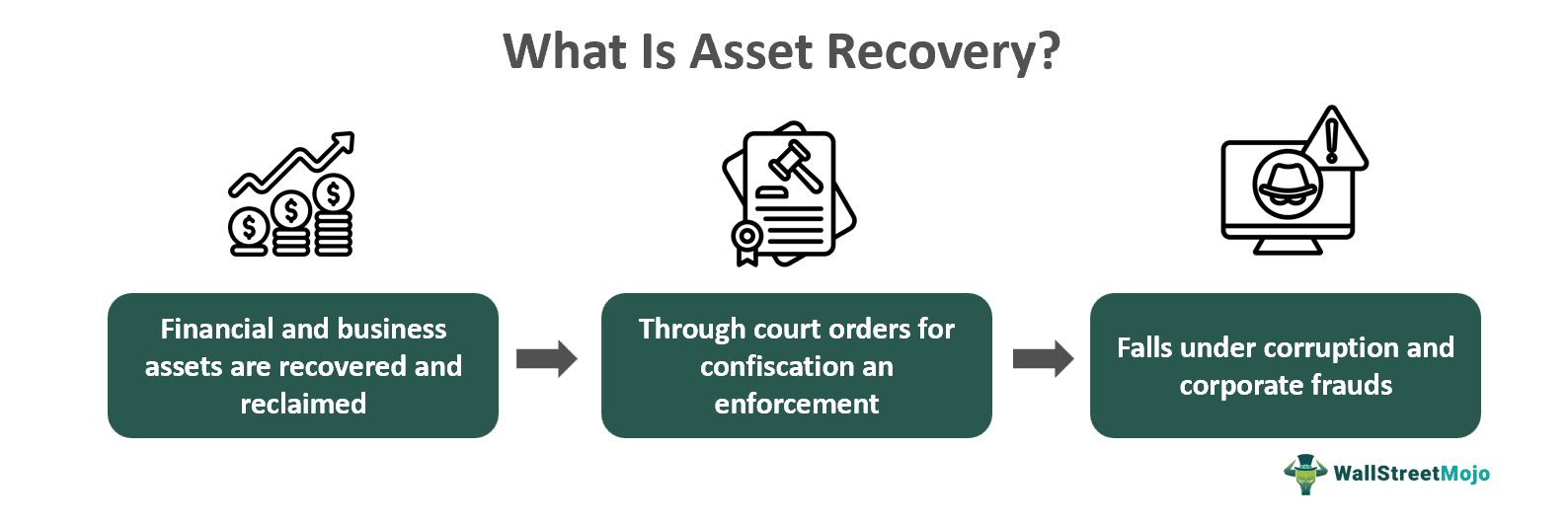Table of Contents
What Is Asset Recovery?
Asset recovery is a legal process through which any individual, company, government, or entity finds and recovers resources and assets that were stolen from them by means of corruption and sent to another jurisdiction or foreign country. The whole process of asset recovery relies on various internal and external factors and elements.

The UN Convention against Corruption refers to the return or repatriation of illicit proceeds located in foreign countries, irrespective of whether they were confiscated or not. Asset recovery in finance is also called investment recovery, which ensures the proper utilization of resources and assets to maximize the value of unused or end-of-cycle assets.
Key Takeaways
- Asset recovery is the reclaiming of assets stolen or confiscated through corruption and fraudulent activities and sent to foreign lands.
- It also refers to companies taking ownership of assets back that are given out on rent and lease. It has three elements: identification, redeployment, and disposition.
- It also refers to companies taking ownership of assets back that are given out on rent and lease. It has three elements: identification, redeployment, and disposition.
- Companies appoint asset recovery agencies to handle such cases and deal with all the legalities and paperwork; the agencies charge a small percentage of the asset value as their fees.
Asset Recovery Explained
Asset recovery elaborates on the process of reclaiming the assets that are stolen or abducted through proceeds of fraud and corruption. The process starts with identifying and tracking the stolen assets or property, freezing and confiscating them, and, lastly, ensuring the complete recovery and return of those assets. It typically includes criminal and civil actions, and a standard link of proof is established to ensure the reclaim of the assets with all aspects of compensation, fines, and damages.
The countries involved have to go through a long process of establishing proof in such cases and highlighting the link between the asset and the offense. Many asset recovery agencies charge a fee, which is a small percentage of the total asset value for their services, and are appointed by organizations to handle such cases. Once a court orders the confiscation or seizure of such assets, another process with dedicated steps is initiated to enforce and function the recovery process. In business and finance, asset recovery also points towards another process where businesses track assets that are reaping no returns and exist with no utility and thus engage in the process of identifying them, redeploying, or, in no use scenario, disposing of them forever.
The whole process is lengthy, starting from identifying the assets, collecting data, proofs, and evidence, and initiating ownership rights, followed by domestic cooperation and international coordination in securing assets. It further requires court orders, requests, and enforcement to start the asset recovery and return process.
Elements
In the context of finance, asset recovery is used as a form of liquidation of excess inventory or taking back the ownership of the asset at the end of the lease; it has three main elements -
- Identification - It is the first step to identify the assets that are not currently in use but are costing money to the firm. Such assets have evidently become liabilities. Companies need to spot such unproductive assets and then take further required action on them. These can be anything from land, equipment, machinery, buildings, or other fixed assets.
- Redeployment - The second element of asset recovery starts with the redeployment of assets that only exist without any return, use, or profit. This element ensures that all such assets that can be put to further use are redeployed. Such activities also remove the need to purchase new assets.
- Disposition - This process is done only when the company decides not to redeploy the assets or if the asset has reached the end cycle and cannot be further utilized. When no appropriate use of assets can be found, the organizations finally dispose of the assets. If the process is conducted correctly, the companies can earn from the disposition of assets as well.
Examples
Here are two distinct examples of asset recovery -
Example #1
Suppose a US-based company that also runs international operations buys a piece of land in the UK for prospect and expansion. With time, the company had other projects going on, and it just remembered the UK investment in the property. After a year or two, the management found that their asset had been stolen from them through corruption and fraudulent activities.
Now, the whole process of asset recovery begins; the US-based company has to prove the ownership through documentation, property papers, and other legal bills and supporting evidence. A link between them has to be established; the whole process will include court proceedings, criminal and civil actions, compensation, damages, and fines.
The US-based company proves the ownership, and finally, the court orders a repatriation of assets. It is a simple asset recovery example. In the real world, it is a long, tiresome process that involves a lot of legalities, international cooperation issues, communication, and transparency problems.
Example #2
In the second example, the European Union Council passed a new law on asset recovery and confiscation. The adoption of a new law will set out minimum rules and regulations on tracing, identification, freezing, confiscation, and management of assets that were stolen or are categorized as criminal property in connection to a series of crimes.
The law will also ascertain that all the EU countries oblige the authorities and offer all the resources they need for their operations. The same rule will be applicable to the violation of sanctions. As per the new EU law, member states will be required to freeze the property in the event of final conviction and also adopt rules allowing the authorities to confiscate property of a value.
Laws And Regulations
The laws and regulations governing the asset recovery process are -
- Article 53 of the United Nations Convention Against Corruption offers direct recovery of assets. A foreign state is able to launch a civil action in a foreign jurisdiction to denote the ownership title of an asset.
- The UNCAC Article 53 enables courts to order compensation or damages to a foreign state and recognize the legitimate asset owners.
- According to the direct recovery of assets through the use of civil proceedings mentioned in Article 53, the defrauded state is represented by counsel. It will stand like an ordinary private plaintiff before the foreign jurisdictions where the corruption is identified and will claim repatriation.
- Through ownership claims, the UNCAC under Article 53. a requires states to take the rightful measures to allow other states to initiate civil action in its courts. At the same time, intervene as a third party in a confiscation process through Article 53C.
- The claim for damages is stated under Article 53. b; the UNCAC requires parties to take the rightful steps to allow other states to stand before their courts and seek compensation for damages caused by the corruption offense.
- There is also Article 35, which provides compensation for damages. It states that the proceeds of corruption should only be recovered on ownership grounds with concrete evidence that the asset was harmed by corruption.
- Once the ownership or damage is established, no further step is needed to prove the basis for repatriation.
Management Of Recovered Asset
The steps followed in the management of recovered assets are -
- The confiscation action can be either raised domestically in the victim country or the recipient countries. Once the confiscation order is sanctioned, assets are not directly repatriated.
- Under UNCAC Article 57, the return and management of recovered assets will follow based on the country. When domestic confiscation occurs, the return and management of assets are requested from the victim country to the recipient country.
- When it is an international confiscation of assets, assets may be returned either directly through court orders or through sharing agreements in line.

